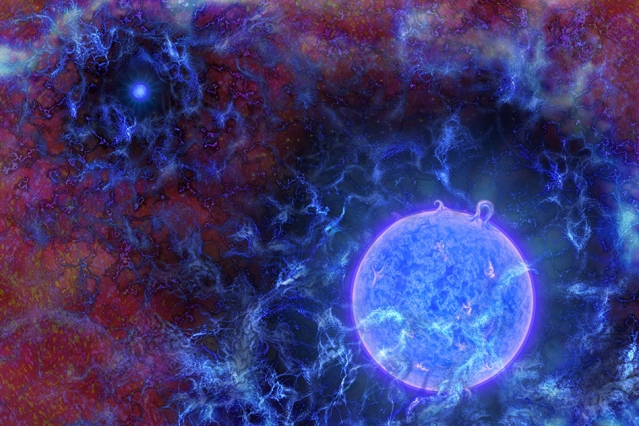Astronomers have detected light from the “cosmic dawn,” the primordial epoch when the universe’s first stars began to shine. The long-sought discovery could throw open a window onto a previously inaccessible era, revealing the rise of stars and galaxies. The findings also offer new clues about dark matter, a mysterious substance that makes up 80 percent of matter in the universe. See also: Dark matter; Galaxy; Galaxy formation and evolution; Matter (physics); Star; Universe

The ancient light the researchers detected, in the form of radio waves, dates back to 180 million years after the big bang. Hydrogen gas that suffused the early universe emitted these radio waves when the gas started absorbing the relic radiation of the big bang, called the cosmic microwave background. The hydrogen only could have absorbed this microwave background, though, if the gas’s energy state had been changed by ultraviolet light. That ultraviolet, in turn, only would have become available when the first stars ignited. Accordingly, the radio waves serve as a clear indicator of the timing of the cosmic dawn. See also: Big bang theory; Cosmic background radiation; Energy; Energy level (quantum mechanics); Excited state; Gas; Ground state; Hydrogen; Light; Radio; Ultraviolet radiation
Challengingly for astronomers, this telltale radio wave signal falls within the bands abundantly used for FM radio and emitted naturally by the Milky Way galaxy. Ferreting out the signal, then, is akin to hearing the flap of a hummingbird’s wing in the middle of a hurricane. To have any chance at success, the researchers placed a small, ground-based radio antenna, dubbed the “Experiment to Detect the Global Epoch of Reionization Signature” (EDGES), in a remote region of Western Australia. The scientists then subtracted radio signals from all known natural and artificial sources. This scrubbing of EDGES’ data left behind a tiny, yet robust, signal. Two years of validation work eliminated sources of error, squarely tying the signal’s emission to when the universe was barely one percent of its current age. See also: Milky Way Galaxy; Radio astronomy
The signal, however, provided a surprise. It did not turn up exactly on the radio band where theory had predicted it would. Instead, the absorption signature of the hydrogen behind the radio wave generation displayed twice the amplitude anticipated. Either more radiation than prevailing evidence suggests was somehow present, or, as seems likelier, the hydrogen gas possessed a colder temperature than models had predicted. A plausible way to cool down the primordial hydrogen is through interactions with a hypothetical type of low-mass, dark matter particle. Seeing as scientists have intensively, but fruitlessly searched for heavier sorts of dark matter, the new results points to fresh experimental approaches targeting lighter particles. In this way, the discovery might help in at last bringing dark matter, as it were, to light. See also: Amplitude (wave motion); Elementary particle; Mass; Standard model; Weakly interacting massive particle (WIMP)





